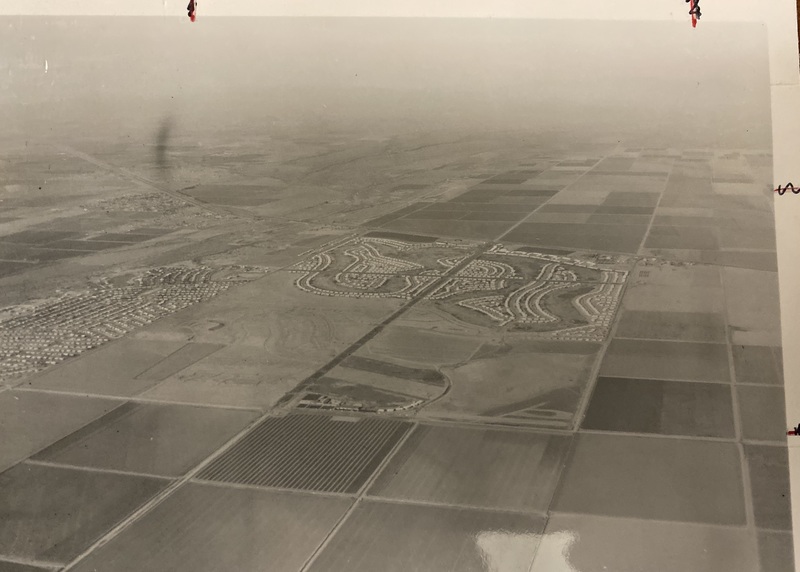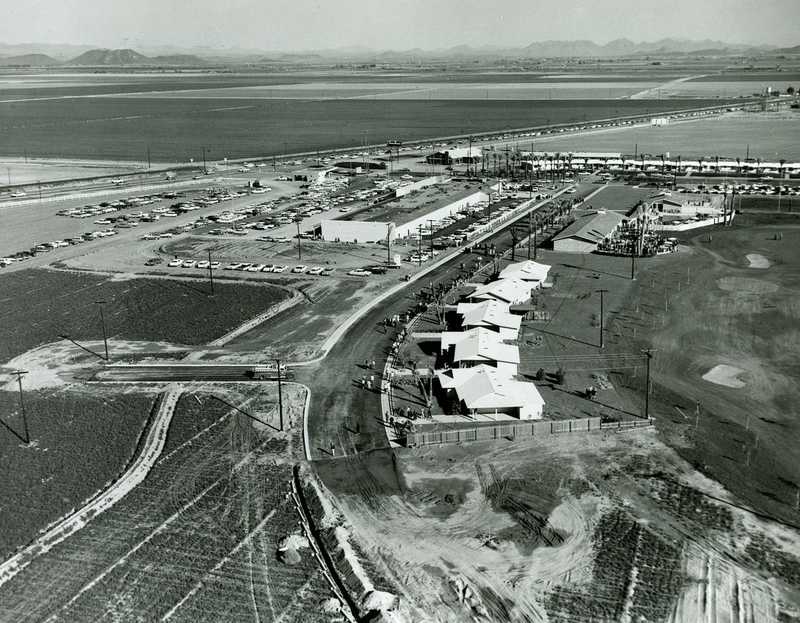Sun City: A Revolution
Sun City; Revolutionizing the Way Retirement Communities are Built Till This Day

Photos by Del E. Webb Corporation, MSS 279, Box 70 Creator: Del E. Webb Development Corporation Date: 1960
Sun City revolutionized housing and retirement in the United States. It became the nation's largest and most successful retirement development and contributed to a new formulation in how Americans thought about life during retirement. It provided reasonably priced housing along with amenities such as golf courses, shopping centers, and activities centers for arts and crafts, meetings, and entertainment. How did Sun City come into existence?
Sun City rose from the vision of Del E. Webb who built his business through developing projects for the local, state, and federal governments in the Southwest. Webb's company DEVCO (Del E. Webb Development Corporation) succeeded largely through procuring contracts funded by the federal government--first as a WPA project during the Depression and later from military contracts during World War II. By 1950, Webb was well-rehearsed in building military installations, commercial buildings, and in manufacturing construction. He even had a little experience in residential construction, having built a company town (San Manuel) in southern Arizona for the Magma Mining Company.
In the 1950s, the idea of building a community exclusively for people entering retirement was a novel idea, perhaps because the very idea of retirement itself did not yet have a long history. In the 1920s the Florida coast beckoned to some retirees. In 1950s Arizona, New York-born developer, Ben Shleifer built the first age-restricted community in Youngtown, Arizona, along the Agua Fria River northwest of Phoenix. Intrigued by these models, Webb and DEVCO's leadership team--known for meticulous research--began investigating this new phenomenon of retirement communities. According to historian Phil Vandermeer, “Webb directed company Vice President Thomas Breen to investigate constructing a retirement community, perhaps in Arizona.” Breen, who had been a champion of the idea, traveled to Florida and discovered that contrary to popular wisdom retirees did not necessarily want to remain close to family and friends in the North. They welcomed the possibilities of retirement and often desired more amenities in the communities to which they moved. With research showing a possible market for an "active" retirement community in Arizona, DEVCO moved forward with its project plans and started to search for land. DEVCO sought a large piece of affordable land, which took him to Jim Boswell and the edges of Phoenix.
At mid-century, Phoenix remained largely oriented around agriculture, but that was rapidly changing in the post-war era. So it was not at all surprising that when Boswell heard of Webb's interest in locating a plot of land to build his planned community that he offered to sell him his massive 10,000-acre cotton farm, land once owned by the Goodyear Tire Company for its cotton enterprise. Following World War II, softening demand for cotton as well as urban growth pressures in Phoenix altered the economy in the region. Farms became more valuable for their land than for the materials they produced, spurring growth across former cotton, citrus, and cattle ranches across Maricopa county. Boswell found a ready purchaser in Webb and the two formed a partnership; in exchange for his land, Boswell acquired part ownership in the project. As exhibits at the Dell Webb Sun Cities Museum reported, “Jim Boswell saw the potential and formed a partnership with Webb, becoming a 49% owner in the Del E. Webb Development Corporation (DEVCO) with Del holding 51%.” Moreover, the agreement stipulated that Boswell could continue farming and that the partners would only buy land as it was needed for developing new subdivisions.
DEVCO moved quickly toward building the new subdivision and, perhaps, most importantly, it imagined retirement to be active rather than sedentary. The company first built the amenities that it hoped would draw buyers and make the community a more vibrant leisure-oriented retirement. In July 1959, DEVCO set to work building a nine-hole golf course, a clubhouse, lakes, a shopping center, and several model homes. Radio jingles from 1960 reflected the new ethos of retirement living as being a year-round vacation.
"Wake up and live in Sun City
For an active new way of life.
Wake up and live in Sun City
Mr. Senior Citizen and wife.
Don't let retirement get you down!
Be happy in Sun City; it's a paradise town."
Designing retirement communities around active leisure would transform Americans' sense of retirement and help to revolutionize the real estate business. In addition, by building Sun City around centers of activity, including a civic center, Webb set the town apart and drew on the most forward-thinking design ideas of the era. On January 1st, 1960, Webb unveiled Sun City with surprising and resounding success. On the first weekend alone tens of thousands of people visited, some estimates put the number at more than 100,000 people. The company wrote so many contracts it ran out of the pre-printed forms; salesmen sat on the floor to write contracts. By April, DEVCO had sold all 400 homes that were slated to be built that year.
The homes also sold because they were affordable. DEVCO sold homes that cost between $8,000 to $11,300, below the median home value in the United States in 1960, according to the United States Census. DEVCO kept the costs down by employing the mass production methods deployed in earlier innovative master-planned communities, such as Levittown, developed in New York in 1947. The company's photos reveal the process: workers cleared the land, laid foundations, framed the simple dwellings, built roofs and walls, added windows, and so forth. Not surprisingly, as demand for the inexpensive though simple homes grew, so too did demand for more elaborate homes.
Once the novelty wore off, Webb and Devco worked to remain ahead of the demand curve, and to keep the Sun City's sales and growth brisk. The company engaged in an ongoing process of trial and error in finding better ways to sell the community. These marketing efforts included a “try before you buy” program that prompted potential buyers to come and view the community up close. By emphasizing community life, Meeker used the residents as a sales force; potential residents did not just buy a home but they bought into an active human community. Ultimately, Sun City became the largest development by a single builder in the country in history. Sun City encompasses more than 25,000 homes, 50 percent larger than the storied Levittown project in New York that has come to symbolize the post-war housing boom. The success of Sun City brought Del Webb national attention. Time Magazine even named him its 1962 “Man of the Year.”
Images

Photos by Del E. Webb Corporation, MSS 279, Box 70 Creator: Del E. Webb Development Corporation Date: 1960

Photos by Del E. Webb Corporation, MSS 279, Box 72 Creator: Del E. Webb development Corporation Date: 1961

Photos by Del E. Webb Corporation, MSS 279, Box 70 Creator: Del E. Webb Development Corporation Date: 1961

Photos by Del E. Webb Corporation, MSS 279, Box 70 Creator: Del E. Webb Development Corporation Date: 1960

Photos by Del E. Webb Corporation, MSS 279, Box 70 Creator: Del E. Webb Development Corporation Date: 1960